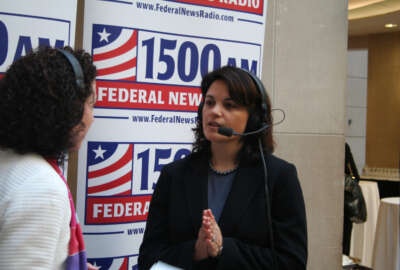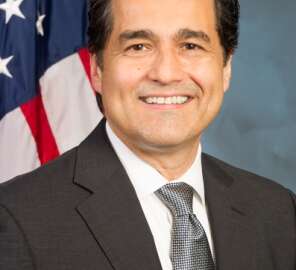
‘Continue the momentum with employee engagement’ says outgoing HUD secretary
Secretary of Housing and Urban Development Julian Castro, after presiding over two-year of workforce and process improvements at the agency, has a few suggestions...
Secretary of Housing and Urban Development Julian Castro, after presiding over two years of workforce and process improvements at the agency, has a few suggestions for his successor and the incoming administration.
“[The new administration] should continue the momentum with employee engagement, continue to look for ways to make the department more efficient in hiring, in approvals for any number of different programs,” Castro said in an interview following a Jan. 11 farewell to his agency.
In 2015, HUD rose 8 points on the Partnership for Public Service’s Best Places to Work rankings. In 2016, it rose another 5.9 points. In those two years, the department also saw a 10-point increase on the Federal Employee Viewpoint Survey on employee engagement. While HUD is still a fairly low-ranked agency on both scales, these numbers reflect noteworthy gains.
“You compete against yourself on this thing. This is a significant increase. And we increased our score on 70 of the 71 questions asked,” HUD Deputy Secretary Nani Coloretti said during the farewell address. “A move of 2 points on any one question or index in the Federal Employee Viewpoint Survey is seen as a success. … We moved 10 points in two years.”
In addition, Coloretti said more employees filled out the FEVS survey than ever before, and the number that said they believed the results of the survey would be used to improve the agency jumped by 13 points.
Both Castro and Coloretti agreed on just what was responsible for those gains.
“The number-one thing that worked was empowering our employees to help lead change at HUD,” Castro said. “Listening to employees was probably the biggest factor, making employees feel like they have a say in the workplace. To my mind, that was the number-one reason.”
It seems Dr. Ben Carson, President-elect Donald Trump’s pick to succeed Castro, seems to agree on the importance of listening to employees.
“Instead of just listening to the sage people of Washington, D.C. — and there are some wise people here — I want to go on a listening tour,” Carson said during his Jan. 12 confirmation hearing in front of the Senate Banking Committee. “I want to hear from the people with boots on the ground who are actually administering programs, who are benefiting from programs. I want to see what actually works and what does not work.”
“We have people who’ve been there for 10, 20, 30, even 40 years,” he added. “And I don’t think a lot of people listen to what they have to say. I suspect that they have garnered a tremendous amount of information, and I want to get that information from them. I want to work with them on a regular basis.”
HUD has faced a number of challenges in the past several years revolving around employee engagement and retention. Employee attrition has been a major hurdle since 2010; despite hiring initiatives aimed at trying to reverse the process, the agency now has about 1,400 fewer employees than it had in 2010.
“It’s no question that one of the challenges the organization continues to face is attrition. We had a lot of folks who were near retirement age. The 2009-2010 timeframe was also coming on the heels of the stimulus, and there was an increase of employees during that time, and so there was some natural dropout,” Castro said. “This is the first organization I’ve ever been a part of that attrites more people that we’ve been able to hire or keep, and we’ve worked very hard to turn that around, and have made some improvement, but a lot still has to be done.”
He said the agency needs to continue to focus on improving the hiring process, making it faster and more efficient. In addition, he said the agency should continue to improve retention by focusing on employees who have been with the agency less than five years.
Because of this attrition, the agency has struggled to keep up with its workload. Coloretti said the solution has been to focus on improving the efficiency of the processes the agency uses. She presided over what she referred to as the “Deep Dive,” where HUD turned the spotlight inward and examined 18 different project areas, including hiring, procurement and acquisition to see what processes could be improved.
“We improved the time it takes to approve rental assistance demonstration projects — that’s our pilot program to recapitalize public housing — we improved by 40 percent our time end-to-end to approve those projects. That’s an incredible, incredible increase. And that is how you do more with less: you actually focus on improving process,” she said.
That’s just one instance where improving efficiency has helped the agency achieve its goals.
“We’re using this kind of process to improve our grants process, our hiring process, and a whole host of others,” she said.
In addition, the agency has invested in improving its leadership, including training for every manager and supervisor, and creating a new pipeline to help employees reach senior leadership positions.
But Castro and Coloretti didn’t get the chance to fully address every issue that afflicts the agency.
“Another item on the agenda should be the IT systems,” Castro said. “Our IT systems are woefully out of date and we’ve been in the middle of transforming that. There’s still work and a lot of resources that need to go into bringing our IT systems up to date, so that’s another challenge.”
Copyright © 2024 Federal News Network. All rights reserved. This website is not intended for users located within the European Economic Area.
Daisy Thornton is Federal News Network’s digital managing editor. In addition to her editing responsibilities, she covers federal management, workforce and technology issues. She is also the commentary editor; email her your letters to the editor and pitches for contributed bylines.
Follow @dthorntonWFED





